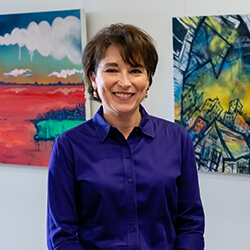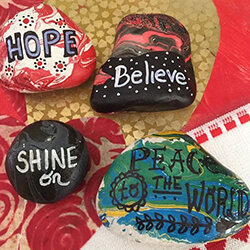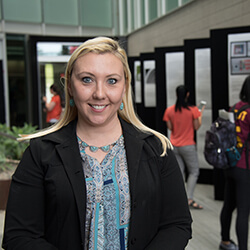Art and Humanities Bring Community Together During Pandemic
To bring the community together during the novel coronavirus pandemic, faculty at the University of Arizona College of Medicine – Phoenix are engaging colleagues and the public through art and humanities.

“I am directly trying to respond to the stress that people are feeling, as well as the feelings of being displaced from their workplace or school and groups of friends or colleagues during the coronavirus pandemic,” Dr. Standley said. “I hope that by posting various prompts for people to respond to, it will help them recover a sense of joy.”
Led by Dr. Standley, the Art in Medicine program created an art forum that features a new theme or art challenge each week.
A few activities they’ve presented include painted rocks with inspirational words to use for yourself or to leave for others to find, photos of signs of hope and a toilet paper roll mashup where participants were challenged to make something out of an empty roll of toilet paper.

Dr. Standley said her online posts are meant to appeal to a variety of interests.
“I am trying to post things that brighten our day, while also sharing information about art exhibits at the Phoenix Art Museum that will be fantastic to see in person once it opens again,” she said.
The Art in Medicine website has had an average of at least 100 new visitors to the site each week, and more than 500 new visits. Participation has come from all facets of campus, including students from UA and Northern Arizona University, staff and faculty. Additionally, Dr. Standley was recently the featured speaker for a Wellness Wednesday session organized by U of A Health Sciences, where she discussed the shift to optimistic thinking though art and how art plays an important role in staying positive during stressful times.
The Narrative Medicine and Health Humanities program, led by Dr. Hartmark-Hill, has created a shared community and connectedness through stories of lived experiences. Their website showcases these stories and many wellness resources for self-care during the pandemic.
“Medicine and science tell us how to fight illness,” Dr. Hartmark-Hill said. “The humanities remind us why we do what we do to take care of one another and work to create a better world.”
The platform gives medical professionals, students, faculty and the community the ability to have a shared virtual space to provide unique perspectives and insight.

As part of the wellness resource, Dr. Hartmark-Hill shared information for reflection and resilience. “While many of our established routines and schedules have been disrupted, now is the time to be intentional to create adaptive practices that will move us into the future with meaning and purpose,” she said.
Dr. Hartmark-Hill provided ideas to meet workday wellness needs like mindfulness Mondays, motivational Tuesdays, wellness Wednesdays, gratitude Thursdays and fun Fridays. She also advised individuals to take a little time and write about an experience you would like to further reflect upon.
“Whole person health depends on staying connected, meaning making and having a sense of purpose,” Dr. Hartmark-Hill said. “Sharing our stories during this time and supporting one another is essential to staying resilient.”
So far, Dr. Hartmark-Hill has received notes of gratitude from students and many positive reactions via social media. She is reaching out to colleagues at other medical schools nationally to share ideas for collaboration, and hopes many more people will participate and stay connected.
About the College
Founded in 2007, the University of Arizona College of Medicine – Phoenix inspires and trains exemplary physicians, scientists and leaders to advance its core missions in education, research, clinical care and service to communities across Arizona. The college’s strength lies in our collaborations and partnerships with clinical affiliates, community organizations and industry sponsors. With our primary affiliate, Banner Health, we are recognized as the premier academic medical center in Phoenix. As an anchor institution of the Phoenix Bioscience Core, the college is home to signature research programs in neurosciences, cardiopulmonary diseases, immunology, informatics and metabolism. These focus areas uniquely position us to drive biomedical research and bolster economic development in the region.
As an urban institution with strong roots in rural and tribal health, the college has graduated more than 1,000 physicians and matriculates 130 students each year. Greater than 60% of matriculating students are from Arizona and many continue training at our GME sponsored residency programs, ultimately pursuing local academic and community-based opportunities. While our traditional four-year program continues to thrive, we will launch our recently approved accelerated three-year medical student curriculum with exclusive focus on primary care. This program is designed to further enhance workforce retention needs across Arizona.
The college has embarked on our strategic plan for 2025 to 2030. Learn more.